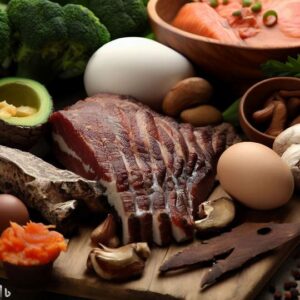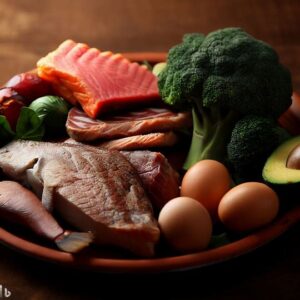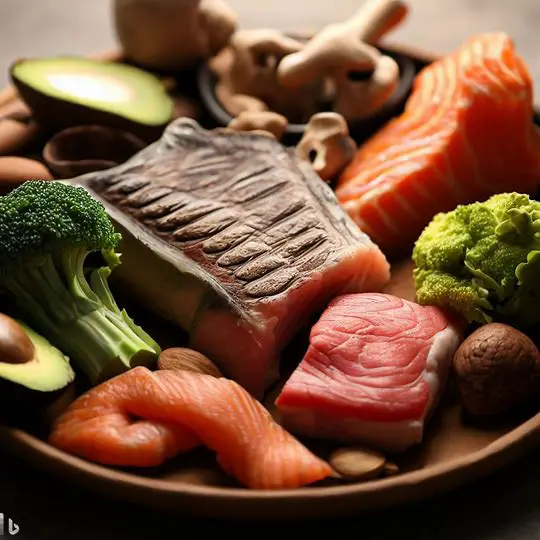How Does Paleo Diet Affect High Blood Pressure? Uncover the Connection Between Paleo Eating and Hypertension Control. Learn about the Potential Benefits and Risks of Adopting a Paleo Lifestyle. Take Charge of Your Health Today. Read Now!
The Paleo diet has gained immense popularity in recent years as it promises to improve overall health and well-being by mimicking the diet of our ancient ancestors. The diet primarily consists of foods available to our ancestors during the Paleolithic era, including lean meats, fish, fruits, vegetables, nuts, and seeds, excluding grains, legumes, dairy products, and processed foods.
But how does the Paleo diet affect high blood pressure? This is an important question since high blood pressure, also known as hypertension, is a leading risk factor for heart disease, stroke, and other health complications. In this blog post, we will explore the relationship between the Paleo diet and high blood pressure and whether the diet can be useful in managing hypertension.
Table of Contents
Explanation of high blood pressure and its potential health risks

High blood pressure, also known as hypertension, is a condition where blood pressure against the arteries’ walls is consistently too high. This can cause damage to the arteries, leading to potential health risks such as heart disease, stroke, and kidney damage. High blood pressure can be caused by genetics, a poor diet high in sodium and saturated fats, and a lack of physical activity. Maintaining healthy blood pressure levels is important to reduce the risk of these health complications. This blog post will examine how the Paleo diet can help lower high blood pressure levels.
Overview of studies and research done on the effects of the Paleo diet on high blood pressure
Several studies have been conducted to determine the correlation between the Paleo diet and its effect on high blood pressure. A 2014 study published in Cardiovascular Diabetology showed that following a Paleo diet for eight weeks can significantly reduce blood pressure, blood sugar, and cholesterol levels. Another study published in the European Journal of Clinical Nutrition found that the Paleo diet reduced systolic blood pressure in overweight individuals. Additionally, a review of several studies published in the American Journal of Clinical Nutrition indicated that consuming a Paleo diet can improve cardiovascular health and reduce the risk of developing high blood pressure. These results suggest that following a Paleo diet can positively impact individuals with high blood pressure.
Discussion on the Paleo diet’s emphasis on fruits, vegetables, and lean proteins and their positive impact on blood pressure
Following the principles of the Paleo diet may potentially have a positive effect on managing high blood pressure. The diet emphasizes whole foods such as fruits, vegetables, and lean proteins. These foods contain essential nutrients that help lower blood pressure and improve cardiovascular health.
Fruits and vegetables are rich in antioxidants, vitamins, and minerals that support a healthy heart and blood vessels. By replacing processed and high-sodium foods with these nutrient-dense options, blood pressure can decrease over time.
Moreover, lean proteins from poultry, fish, and nuts may also benefit blood pressure levels. These protein sources are low in saturated fats and contain essential amino acids that support muscle function and aid in maintaining a healthy weight, another contributing factor to overall cardiovascular health.
In summary, incorporating more fruits, vegetables, and lean proteins according to the Paleo diet principles may improve high blood pressure by providing the body with essential nutrients while avoiding high-sodium and processed food.
Explanation of the Paleo diet’s exclusion of processed foods and its potential benefits for high blood pressure
The basic principle of the Paleo diet is to stick to the natural and unprocessed foods that our ancestors used to consume. This means excluding anything that has been highly processed, including refined carbohydrates, sugars, industrial seed oils, and dairy products.
This exclusion benefits high blood pressure because processed foods, fast foods, and junk foods are the primary culprits behind this condition. These foods are usually high in sodium, unhealthy fats, and refined sugars, which can increase blood pressure levels.
By eliminating these foods, individuals on the Paleo diet can benefit from naturally low-sodium, low-fat, and nutrient–dense foods like fresh fruits, vegetables, lean meats, nuts, and seeds. These foods are rich in potassium, magnesium, and dietary fiber, all known to promote healthy blood pressure levels.
Furthermore, the Paleo diet encourages healthy weight management, a crucial factor in managing high blood pressure. Excess weight and obesity are well-known contributors to high blood pressure, and by promoting weight loss through healthy eating habits and regular exercise, the Paleo diet offers a holistic approach towards managing the condition.
In conclusion, the Paleo diet’s exclusion of processed foods and focus on natural, unprocessed foods can significantly impact high blood pressure. The diet promotes healthy weight management, provides essential nutrients, and minimizes the intake of sodium, unhealthy fats, and refined sugars. It is an excellent option for those seeking a diet that can help them manage their blood pressure levels naturally.
Discussion on the Paleo diet’s lower sodium intake compared to the standard American diet and its potential role in reducing high blood pressure
The Paleo diet has been gaining popularity recently due to its association with numerous health benefits, including potentially reducing high blood pressure. One of the main reasons for this benefit is the lower sodium intake compared to the standard American diet.
The standard American diet is high in processed foods loaded with sodium to enhance flavor and preservation. On the other hand, the Paleo diet promotes the consumption of whole foods, which are naturally low in sodium. The emphasis is on fresh fruits and vegetables, lean proteins, and healthy fats, which are nutrient-dense and naturally low in sodium.
Several studies have shown that reducing sodium can help to lower blood pressure levels. A high sodium diet increases blood pressure because excessive sodium causes the body to retain water, burdening the heart and blood vessels. Conversely, low-sodium diets have been shown to lower blood pressure levels.
The Paleo diet’s emphasis on whole foods and low sodium intake could help reduce high blood pressure. The diet is also rich in potassium, magnesium, and calcium, which have been shown to have blood pressure-lowering effects. However, it is worth noting that individual results may vary, and a balanced diet rich in whole foods is recommended for overall health benefits.
In summary, the Paleo diet’s lower sodium intake compared to the standard American diet could play a crucial role in reducing high blood pressure levels. The emphasis on whole, nutrient–dense foods could promote overall health and well-being. As always, it is essential to consult with a medical professional before making any significant dietary changes, especially if you have an underlying health condition.
Mention of the controversy surrounding the consumption of high levels of animal protein in the Paleo diet and its potential impact on blood pressure

Despite the numerous benefits touted by the Paleo diet, there are concerns about the potentially harmful effects of consuming high levels of animal protein. One of the main concerns is its impact on blood pressure. Studies have shown that a high animal protein diet may increase blood pressure, harming people with high blood pressure or those at risk of developing it.
However, many proponents of the Paleo diet argue that the diet is not solely focused on high levels of animal protein. The diet promotes the consumption of fruits, vegetables, nuts, and seeds, which are low in sodium and potassium, a mineral proven to help lower blood pressure.
Moreover, proponents argue that the Paleo diet has been shown to improve overall health and can help reduce the risk of chronic illnesses such as heart disease, which is closely linked to high blood pressure.
To mitigate the risks associated with a high animal protein diet, the Paleo diet encourages the consumption of leaner cuts of meat and recommends Healthy Fat Choices rather than unhealthy saturated fats. It also emphasizes the avoidance of processed and packaged foods that are high in sodium.
In conclusion, while there is a controversy surrounding the consumption of high levels of animal protein in the Paleo diet, there are ways to mitigate these risks. By following the Paleo diet with the right modifications, individuals can reap the benefits of reduced risk of chronic disease while maintaining healthy blood pressure levels.
[wl_faceted_search]
Discussion on the role of exercise and stress management in managing high blood pressure while on the Paleo diet
It is important to note that managing high blood pressure is not only about food intake but also other lifestyle factors. When following a paleo diet, it is also essential to incorporate exercise and stress management techniques to help regulate blood pressure.
Regular exercise can improve cardiovascular health, aid in weight loss, and reduce stress levels. It is recommended to aim for at least 30 minutes of moderate-intensity exercise, such as brisk walking or cycling, on most days of the week.
In addition to exercise, practicing stress management techniques such as meditation, deep breathing, and yoga can help reduce cortisol levels and promote relaxation. High cortisol levels have been linked to high blood pressure, so incorporating stress management techniques can complement the paleo diet in managing blood pressure levels.
Overall, while the paleo diet can be beneficial in managing high blood pressure, it is important to consider other lifestyle factors such as exercise and stress management. Consulting with a healthcare professional and registered dietitian can help create a comprehensive approach to managing high blood pressure.
How Does Paleo Diet Affect High Blood Pressure? – Conclusion

In conclusion, the Paleo diet has shown promising results in managing high blood pressure. Individuals may improve their blood pressure levels by eliminating processed foods and grains and focusing on whole, nutrient-dense foods. The Paleo diet encourages a reduction in sodium intake, which is important for those with high blood pressure. Additionally, the diet promotes weight loss, which has been linked to decreased blood pressure. While more research is needed to fully determine the long-term effects of the Paleo diet on blood pressure, it’s a promising approach for those looking to improve their overall health and manage hypertension.
Overall, the Paleo diet appears to positively affect high blood pressure because it emphasises whole, nutrient-dense foods and eliminates processed and high-sodium foods. However, as with any dietary changes, it is important to consult a healthcare professional before making any drastic changes. Additionally, individuals with high blood pressure should not rely solely on dietary changes and should work with a medical professional to develop a comprehensive treatment plan.
How Does Paleo Diet Affect High Blood Pressure? –
Sources
– National Heart, Lung, and Blood Institute (NHLBI). (2017). DASH Eating Plan. Retrieved from https://www.nhlbi.nih.gov/health-topics/dash-eating-plan
– Academy of Nutrition and Dietetics. (2014). Position of the Academy of Nutrition and Dietetics: Total Diet Approach to Healthy Eating. Journal of the Academy of Nutrition and Dietetics, 114(2), 307-317. doi: 10.1016/j.jand.2013.12.002
– Sacks, F. M., et al. (2001). Effects on blood pressure of reduced dietary sodium and the Dietary Approaches to Stop Hypertension (DASH) diet. New England Journal of Medicine, 344(1), 3-10. doi: 10.1056/NEJM200101043440101
– Eaton, S. B., et al. (2002). Paleolithic nutrition revisited: A twelve-year retrospective on its nature and implications. European Journal of Clinical Nutrition, 56(3), 337-342. doi: 10.1038/sj.ejcn.
[wl_chord]
[wl_vocabulary]
